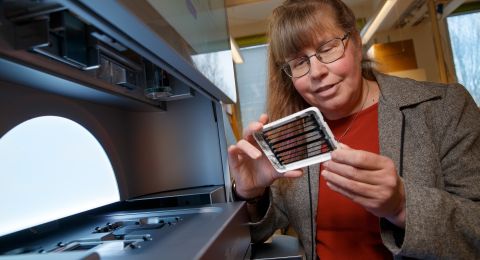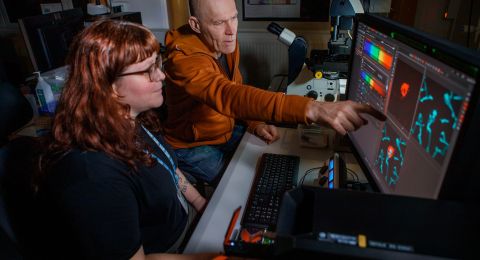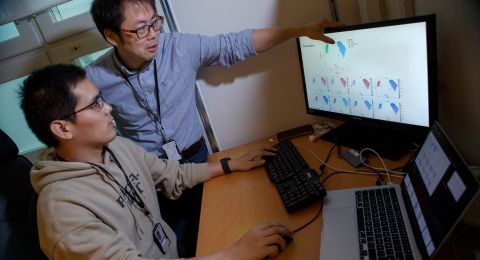In the late 1990s stem-cell research was portrayed as a cure for many diseases. With the aid of stem cells, the human body would be able to repair itself. But apace with the lack of results, more and more people gave up hope. But stem-cell researchers have arduously soldiered on, and breakthroughs have started to appear in recent years.
There are different types of stem cells. Pluripotent stem cells can form all cells found in our bodies. By developing methods to steer stem cells to form the specialized cell types desired, it would be possible to treat certain disorders by replacing dead or defective cells with new cells generated from stem cells.
“However, this has proven to be more easily said than done,” says Johan Ericson, professor of developmental biology at Karolinska Institutet and a 2011 Wallenberg Scholar.
“Finding genes that govern cellular processes is exceedingly expensive. This grant means we can increase our pace without worrying so much about money. Instead we can focus on research.”
Production of dopamine cells
The brain contains roughly 1,000 types of nerve cells. Nearly all are formed relatively early in the fetal period. Nerve cells with special function are formed in various places in the brain and during specific periods during embryonic development. Johan Ericson is interested in understanding the mechanisms that govern nerve-cell development in time and space.
“The idea is if we can identify the genes that govern the emergence of a specific cell during embryonic development, we should also be able to make use of these genes as tools for mass producing important specialized cell types from stem cells.”
Parkinson’s disease, for instance, is caused by the degeneration and death of dopamine-producing cells in the midbrain, which leads to severe motor difficulties. There is now hope that it will be possible to treat the disease by transplanting newly produced dopamine cells.
By studying how dopamine cells develop normally, Johan Ericson, together with some colleagues, was able to identify the genes that govern the emergence of dopamine cells and to use those genes to develop a highly effective method to generate dopamine-producing cells from pluripotent stem cells.
The same scientists have now created similar methods for efficient production of cell types of importance in other neurodegenerative disorders, such as ALS and MS, as well as depression.
“We insert different genes in the stem cells to get the cells to choose specific developmental programs. This works very efficiently in a laboratory environment. But since the cells are genetically modified, it’s doubtful whether the method can be transferred to human cells intended for transplantation,” Ericson explains.

Testing on Parkinson’s patients soon
One problem with pluripotent stem cells has been to get large cell populations to form precisely those cells the scientists want. Even though they have managed to produce dopamine cells, these cells have constituted just a small percentage of all the cells that are developed. Instead most of the cells developed into cells that are not desirable or in the worst case are harmful.
“Our method exceeds others in results regarding both the quantity and the quality of the dopamine-producing cells,” says Johan Ericson.
But the method is not fully developed. One problem remains.
“Today there are several methods for generating dopamine-producing nerve cells of the right kind, but before clinical trials on patients can be started, we need to know that the methods are completely safe.”
Attempts to transplant pluripotent stem cells from mice in animal experiments for Parkinson’s have indicated that a tumor-like overproduction of cells can develop.
“We’re therefore trying to modify our method to get rid of cells that can cause overgrowth of tumors. Today there are actually methods that are ready to enter clinical trials. Even though preliminary data also indicate that human stem cells do not have the same propensity to grow out of control, we need to know for sure that this does not occur before clinical testing can start.”
Johan Ericson is convinced he will succeed.
“Even though I won’t be involved in the clinical part, I believe experiments on Parkinson’s patients will be getting underway relatively soon.”
Important discovery of new signal
The other dimension of developing specialized stem cells that interests Johan is time.
“In the developing brain, there are time mechanisms that make neuronal stem cells develop into different cell types at different times, but how these time mechanisms are regulated at the molecular level is largely unknown.”
Johan and his research team have studied the process that starts with the formation of motor neurons, which guide our motor skills. A process that is suddenly stopped in favor of generating serotonin-producing cells, and when that production ends, oligodendrocytes are formed instead, cells that isolate nerve paths and are important in the development of MS.
“How do they know when they are to begin and end a process? How do they measure time? This is extremely fascinating,” says Johan, who goes on to relate that they have found an important signal.
“We previously knew the signal that prompts the production of motor neurons, but now we have found the one that stops that production and starts the serotonin phase.”

Importance also for depression and cancer
This is an important discovery that can be of great significance for the treatment of depression. The use of anti-depressant drugs, SSRI preparations, which strengthen the serotonin function in the brain, is widespread today.
By identifying the signal molecule that produces serotonin cells during the normal development of the brain, Ericson’s research team has developed a highly effective method for producing an unlimited number of serotonin cells from pluripotent stem cells.
“This provides us with a tool, a cellular platform, that can be used to develop drugs. The signal we found means we can now start serotonin production directly for the first time, without having to go via the development of motor neurons,” says Johan Ericson.
This discovery will also bring new knowledge for brain cancer research, as the signal the team found has previously been associated with the formation of tumors in other organs in the body.
Text Carina Dahlberg
Translation Donald S. MacQueen
Photo Magnus Bergström






